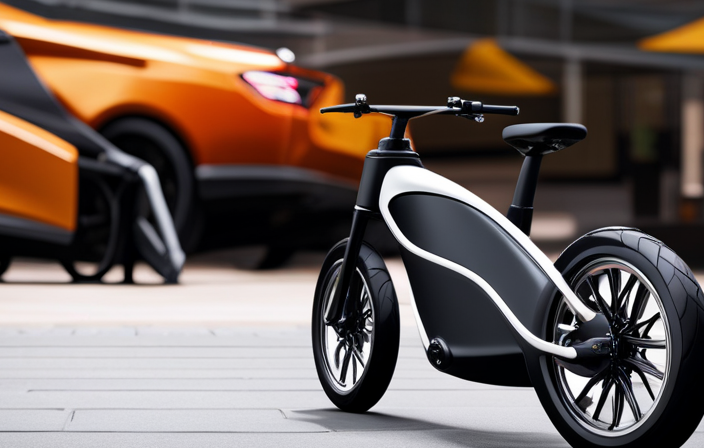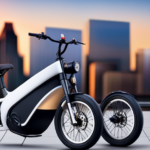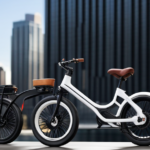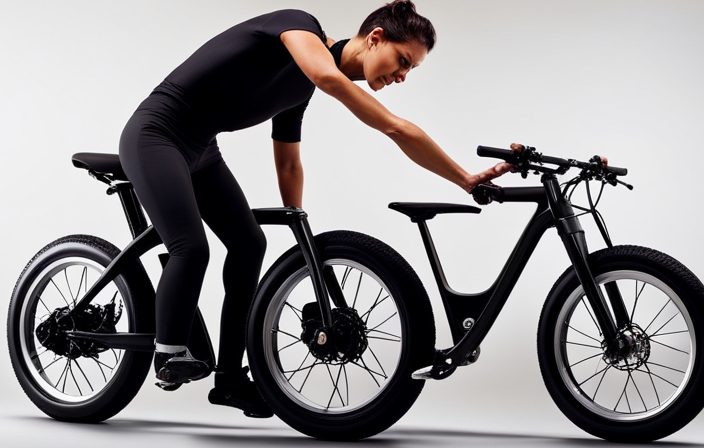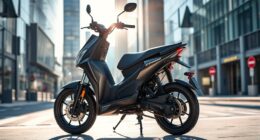As an avid cyclist, I’ve always been curious about the cost of electric bikes. Did you know that the average price of an electric bike ranges from $500 to $10,000?
In this article, I will explore the various types of electric bikes and the factors that affect their price. Whether you’re on a tight budget or looking for a high-end model, I’ll provide valuable insights to help you find the perfect electric bike for your needs.
So, let’s dive in and discover the true price of electric bikes.
Key Takeaways
- The price of an electric bike can vary depending on factors such as motor type and power, battery capacity and range, frame material and quality, and additional features and accessories.
- Motor type and power play a significant role in determining the price of an electric bike, with hub motors generally being less expensive than mid-drive motors.
- Battery capacity and range are important considerations when determining the price of an electric bike, as models with larger battery capacities and longer ranges tend to be more expensive.
- The choice of frame material can also impact the price, with aluminum frames being more affordable, carbon fiber frames being more expensive but lightweight and strong, steel frames being durable but heavier, titanium frames being strong and lightweight but expensive, and magnesium frames being lightweight but less durable.
Types of Electric Bikes
If you’re looking for different types of electric bikes, you’ll find that there are several options available in the market.
One popular type is electric mountain bikes, which are designed for off-road adventures. These bikes come equipped with powerful motors and sturdy frames to handle rugged terrains. They often have specialized suspension systems to provide a smooth and comfortable ride.
Another type is folding electric bikes, which are perfect for those who need a compact and portable option. These bikes can be easily folded and stored in small spaces, making them ideal for commuters or people with limited storage space.
Factors affecting the price of electric bikes include the brand, features, and battery capacity.
Factors Affecting the Price
When considering the factors that affect the price of an electric bike, there are several key points to consider.
Firstly, the motor type and power play a significant role in determining the overall cost.
Secondly, the battery capacity and range are important factors to consider, as a larger capacity battery with a longer range will generally result in a higher price.
Lastly, the frame material and quality, as well as additional features and accessories, can also contribute to the overall cost of the electric bike.
Motor Type and Power
The motor type and power greatly affect the price of an electric bike. The motor type refers to the kind of motor used in the bike, whether it’s a hub motor or a mid-drive motor. The power, on the other hand, refers to the amount of energy the motor can produce, measured in watts.
Here are three key factors to consider when it comes to motor type and power consumption:
-
Efficiency: Different motor types have varying levels of efficiency, meaning some motors may consume more power than others to achieve the same level of performance.
-
Performance: Higher power motors generally offer better acceleration and climbing ability, but they also tend to consume more energy, reducing the overall range of the bike.
-
Cost: Motors with higher power output and advanced technologies typically come with a higher price tag.
When considering an electric bike, it’s important to choose a motor type and power that aligns with your specific needs and budget.
Moving on to battery capacity and range…
Battery Capacity and Range
Battery capacity and range are important factors to consider when choosing an electric bike. The battery life determines how long you can ride before needing to recharge, while the range indicates how far you can travel on a single charge. To help you understand the different options available, here is a comparison table:
| Electric Bike Model | Battery Capacity | Range | Charging Time |
|---|---|---|---|
| Model A | 400Wh | 40 miles | 4 hours |
| Model B | 500Wh | 50 miles | 5 hours |
| Model C | 600Wh | 60 miles | 6 hours |
The battery capacity is measured in Watt-hours (Wh) and indicates the amount of energy the battery can store. A higher capacity generally means a longer battery life. The range is an estimation of how far you can ride on a single charge, depending on various factors such as terrain and rider weight. Lastly, the charging time is the duration it takes to fully recharge the battery. Consider these factors when choosing an electric bike to ensure it meets your needs for battery life and charging time. Now, let’s move on to discussing the importance of frame material and quality in an electric bike.
Frame Material and Quality
To find the right frame material and quality for you, consider factors such as durability and weight. The frame material comparison and the impact of frame quality are crucial when choosing an electric bike. Here are some important points to consider:
- Aluminum: Lightweight and corrosion-resistant, it offers a good balance of strength and affordability.
- Carbon Fiber: Extremely lightweight and strong, but more expensive and can be prone to damage from impacts.
- Steel: Known for its durability and strength, but heavier compared to other materials.
- Titanium: Offers a great combination of strength, durability, and lightness, but comes with a higher price tag.
- Magnesium: Provides excellent vibration damping properties and is lightweight, but can be less durable than other materials.
The frame material and quality have a significant impact on the performance, comfort, and longevity of your electric bike.
Now, let’s explore the additional features and accessories that can enhance your riding experience.
Additional Features and Accessories
When considering additional features and accessories, it’s important to think about how they can enhance your riding experience on your electric bike.
There are a variety of options available that can add convenience and functionality to your bike. One popular accessory is a rear rack, which allows you to carry items like groceries or a backpack.
Another useful feature is a built-in headlight, which provides visibility and safety when riding at night. Additionally, some electric bikes come with fenders, which can protect you from splashes and debris while riding on wet roads.
Other accessories to consider include a bike lock, a water bottle holder, and a phone mount. These additional features and accessories can greatly improve your overall riding experience and make your electric bike even more versatile.
Now, let’s move on to discussing entry-level electric bikes and their key features.
Entry-Level Electric Bikes
If you’re looking for an affordable electric bike, there are some great options available in the entry-level range. These electric bike models provide a cost-effective way to enjoy the benefits of an electric bike without breaking the bank. Here are some of the top affordable options in the entry-level electric bike category:
| Brand | Model | Price Range |
|---|---|---|
| A | Model X | $999 |
| B | Model Y | $899 |
| C | Model Z | $799 |
| D | Model A1 | $699 |
| E | Model B2 | $599 |
These entry-level electric bikes offer a range of features and specifications, ensuring that you can find the right fit for your needs and budget. From robust frames to reliable motors, these bikes provide a comfortable and efficient ride. Transitioning to the subsequent section about mid-range electric bikes, you’ll find even more options with additional features and capabilities.
Mid-Range Electric Bikes
The mid-range electric bikes offer a variety of upgraded features and specifications to enhance your riding experience. When it comes to electric bike brands, there are several options to choose from. Some of the best mid-range electric bikes on the market include models from brands like Rad Power Bikes, Aventon, and Ride1Up.
These bikes typically have a higher price point compared to entry-level models, but they also come with better components and more advanced features. For example, you can expect mid-range electric bikes to have more powerful motors, longer battery life, and better suspension systems. These enhancements result in a smoother and more enjoyable ride, whether you’re commuting to work or exploring off-road trails.
As we move into the next section about high-end electric bikes, you can expect even more impressive features and performance.
High-End Electric Bikes
For a top-of-the-line riding experience, you can’t go wrong with high-end electric bikes. These bikes are crafted by the most reputable high-end electric bike brands, ensuring the highest quality and performance.
One of the key advantages of high-end electric bikes is their superior build and components. From top-notch frames to high-end drivetrains, every aspect is designed to provide a smooth and powerful ride. These bikes also often come equipped with advanced features like suspension systems, high-capacity batteries, and cutting-edge motor technology.
This combination of quality craftsmanship and advanced features results in an unparalleled riding experience. As we transition to the next section about used electric bikes, it’s important to consider that even though high-end electric bikes can come with a higher price tag, their exceptional performance and durability make them a worthwhile investment.
Used Electric Bikes
When purchasing a used e-bike, it’s essential to thoroughly inspect the condition and functionality of all components. The used electric bike market offers a range of options, but it’s important to weigh the pros and cons before making a decision.
Here are four key considerations when buying a used electric bike:
-
Condition: Examine the frame for any signs of damage or wear. Check the battery and motor for performance and longevity.
-
Maintenance History: Ask the seller about the bike’s maintenance history. Regular maintenance ensures the bike’s longevity and performance.
-
Warranty: Determine if the bike comes with any remaining warranty. This can provide peace of mind in case of unexpected issues.
-
Price: Compare the price of the used bike with the cost of a new one. Consider the mileage, age, and overall condition to determine if the price is fair.
Considering these factors will help you make an informed decision when buying a used electric bike.
Now, let’s explore the financing options available for purchasing an e-bike.
Financing Options
To finance your purchase of a used e-bike, you can explore different options such as installment plans or applying for a personal loan.
Many electric bike retailers offer payment plans that allow you to pay off the cost of the bike over a set period of time. These plans often come with interest, so it’s important to consider the total cost of financing.
Another option is to apply for a personal loan from a bank or credit union. This can give you more flexibility in terms of repayment and interest rates. It’s important to compare different financing options to find the best fit for your budget and needs.
Once you’ve secured financing for your used e-bike, you can start thinking about the maintenance and repair costs, which are an important consideration for any bike owner.
Maintenance and Repair Costs
You should regularly budget for maintenance and repair costs to ensure the longevity of your used e-bike. Proper maintenance is essential to keep your e-bike running smoothly and avoid costly repairs down the road.
Some maintenance tips include regularly checking tire pressure, cleaning and lubricating the chain, and inspecting the brakes. Common repair issues you may encounter include flat tires, worn brake pads, and battery problems. It’s important to address these issues promptly to prevent further damage.
By staying on top of maintenance and addressing repair issues as they arise, you can extend the lifespan of your e-bike and enjoy a smooth and reliable ride.
Now, let’s move on to some cost-saving tips to help you maintain your e-bike without breaking the bank.
Cost-Saving Tips
One way to save on maintenance and repair costs for your e-bike is by performing regular check-ups and addressing any issues promptly. By doing so, you can catch small problems before they become major and costly repairs.
Additionally, investing in cost-effective solutions and energy-efficient options can help reduce long-term expenses. For example, opting for high-quality components and batteries that have a longer lifespan can save you money in the long run.
It is also important to properly maintain your e-bike’s battery, such as keeping it charged within the recommended levels and avoiding extreme temperatures. By following these cost-saving tips, you can ensure that your e-bike remains in good condition while minimizing maintenance and repair costs.
Transitioning into the subsequent section about government incentives and rebates, taking advantage of these programs can further reduce the overall cost of owning an e-bike.
Government Incentives and Rebates
There’s a wide range of government incentives and rebates available for e-bike owners. These incentives are designed to promote the use of electric bikes and reduce the environmental impact of traditional transportation methods.
One common incentive is a tax credit, which allows individuals to deduct a portion of the cost of purchasing an e-bike from their taxes. Additionally, some states and cities offer grants or rebates for the purchase of electric bikes, making them more affordable for consumers.
These government incentives not only help offset the initial cost of an e-bike but also encourage individuals to choose a more sustainable form of transportation. By taking advantage of these incentives, e-bike owners can contribute to a greener future while saving money in the long run.
Long-Term Cost Savings
To maximize your long-term savings, consider the potential benefits of government incentives and rebates for e-bike owners.
Electric bike brands such as Rad Power Bikes and Trek offer models that not only provide a cost-effective transportation solution but also have a positive environmental impact. By opting for an e-bike, you can reduce your carbon footprint and contribute to a cleaner, greener future.
In addition, many governments around the world recognize the benefits of e-bikes and offer incentives and rebates to encourage their adoption. These incentives can include tax credits, grants, or subsidies, which can significantly lower the upfront cost of purchasing an electric bike.
Taking advantage of these incentives can provide substantial long-term cost savings, making e-bikes an attractive investment for both your wallet and the environment.
With the potential for government incentives and rebates, e-bikes offer an excellent return on investment.
Return on Investment
By taking advantage of government incentives and rebates, you can maximize the return on your investment in an e-bike. E-bikes offer a cost-effective transportation solution, with potential savings in fuel expenses, parking fees, and maintenance costs. The payback period for an e-bike depends on various factors such as the cost of the bike, the distance traveled, and the price of electricity. To help you understand the potential cost savings, here’s a table highlighting the average annual cost of using an e-bike compared to a car:
| Cost Components | E-Bike | Car |
|---|---|---|
| Fuel | $0 | $1,200 |
| Maintenance | $200 | $800 |
| Parking | $0 | $500 |
| Total Annual Cost | $200 | $2,500 |
As you can see, an e-bike can save you around $2,300 per year compared to a car. This demonstrates the cost effectiveness of investing in an e-bike. Now, let’s explore considerations for different budgets to help you make an informed decision.
Considerations for Different Budgets
When considering the return on investment of an electric bike, it’s important to also take into account your budget and the different options available.
With a variety of electric bike models on the market, prices can vary greatly. Here are three key considerations when comparing prices:
-
Features: Different electric bike models come with different features, such as battery capacity, motor power, and suspension. Higher-end models may have more advanced features, but they also come with a higher price tag.
-
Brand: Established brands often charge a premium for their reputation and quality. However, lesser-known brands can offer more affordable options without compromising on performance.
-
Accessories: Some electric bike models come with additional accessories such as racks, lights, and fenders. These extras can add to the overall cost but may be worth it depending on your needs.
Considering these factors will help you make an informed decision based on your budget and requirements.
Now, let’s move on to the next section to learn about the importance of test rides and research when buying an electric bike.
Test Rides and Research
Before making a decision, it’s crucial that you take the time to test ride different models and conduct thorough research to ensure you find the right fit for your needs.
Test riding an electric bike has many benefits. It allows you to experience the bike’s performance, comfort, and handling firsthand. You can assess how well it accelerates, brakes, and handles different terrains. Additionally, it gives you the opportunity to test the bike’s battery life and range, which are important factors to consider.
As for research methods, there are various ways to gather information about electric bikes. You can read online reviews, watch video demonstrations, visit local bike shops, and even join online forums to get insights and recommendations from other electric bike enthusiasts.
By combining test rides and thorough research, you can make an informed decision and find the perfect electric bike for your needs and budget.
Transition: Now that you have tested different models and conducted thorough research, let’s move on to the next section to find the right electric bike for your budget.
Conclusion: Finding the Right Electric Bike for Your Budget
Now that you’ve tested different models and done thorough research, it’s time to find the perfect electric bike that fits your budget. When it comes to finding affordable options, there are a few key steps you can take to compare prices and make a smart purchase decision:
-
Check online retailers and marketplaces: Websites like Amazon, eBay, and Walmart often have competitive prices on electric bikes. Take the time to browse through different listings and compare prices to find the best deal.
-
Visit local bike shops: While online shopping can be convenient, it’s also worth visiting local bike shops to see if they have any discounts or promotions. Sometimes, you can negotiate the price or get additional accessories included in the purchase.
-
Consider buying used: If you’re on a tight budget, buying a used electric bike can be a great option. Check websites like Craigslist or Facebook Marketplace for second-hand bikes in your area. Just make sure to thoroughly inspect the bike and test ride it before making a purchase.
Frequently Asked Questions
Are electric bikes more expensive than regular bicycles?
Yes, electric bikes tend to be more expensive than regular bicycles. This is because they have additional components such as batteries and motors. However, the price difference can vary depending on the brand and features of the electric bike.
How much does it cost to charge an electric bike?
Charging an electric bike typically costs around $0.10 to $0.20 per charge. Electric bike maintenance is generally low, with occasional costs for battery replacement. The benefits of electric bike commuting include reduced carbon emissions and increased physical activity.
Can I convert my existing bike into an electric bike?
Converting my existing bike into an electric one is possible. The process involves adding a motor, battery, and controller. Electric bikes offer numerous benefits like eco-friendliness, cost-efficiency, and ease of commuting.
Are there any hidden costs associated with owning an electric bike?
There are some hidden costs associated with owning an electric bike. Charging time can vary depending on the battery and charger. Additionally, maintenance costs may include replacing the battery, tires, and other components over time.
Are electric bikes covered under insurance policies?
Electric bikes can be covered under insurance policies, with options for electric bike theft coverage. Insurance premiums for electric bikes may vary depending on factors such as the bike’s value, location, and the individual’s insurance history.
Conclusion
In conclusion, finding the right electric bike for your budget requires careful consideration of the various types available and the factors that affect their price.
Interestingly, according to recent market research, the average price of an entry-level electric bike is around $1,000, while mid-range options typically range from $1,500 to $3,000. High-end electric bikes can cost anywhere from $3,000 to $10,000 or more.
It’s crucial to weigh the return on investment, consider your budget, test ride different models, and conduct thorough research before making a decision.
